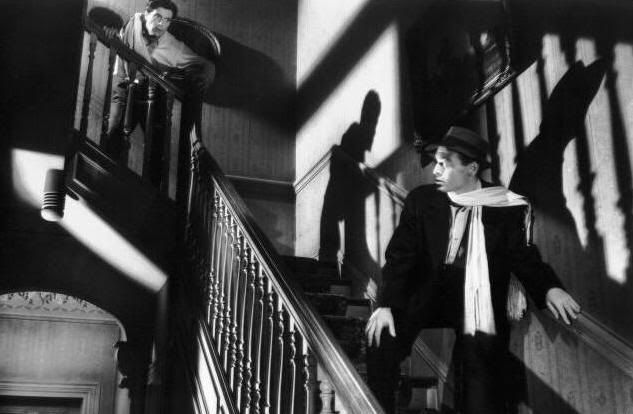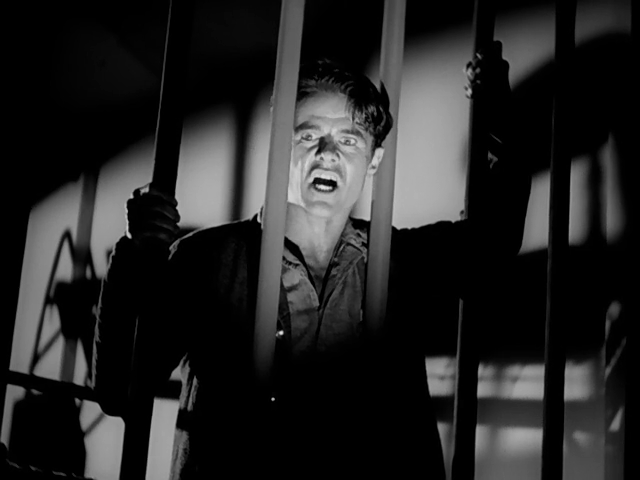
This is my reaction paper from a college film noir class. Originally written in 2003.
Spoiler...
"Stranger on the Third Floor" (1940) is not a true film noir movie. It has many of the elements associated with film noir (heavy use of shadow, narration) and yet the mood of the picture is all wrong. I feel that this is a proto noir film. In other words, if noir films were a long running TV series, this film should be thought of as the pilot of the series. It is a pilot that is so different from the series that it could never be aired. Film noir is bleak and gritty. This movie has a kind of light and peppy mood. It even has a “gosh isn’t everything swell” happy ending.
The most noir part of this movie was the dream sequence in the middle of the film. While not exactly on par with the famous Salvador Dali designed dream sequence from Hitchcock’s "Spellbound," this sequence did have some notable aspects: the jail cell which seemed to be a kind of stage which was surrounded by darkness. The courtroom scenes during this sequence were much darker, the courtroom was empty, and the jury made no attempt to mask their indifference. After his sentencing, the electric chair was seen only as a gigantic imposing shadow. When the judge becomes the statue of justice, it is clear that this movie is hitting the audience over the head with its imagery and moving at a pace that is slow enough that you can go get popcorn and a soda and not really miss anything. To make matters worse, the image of the statue and the cheesy dramatic music that accompanies it are repeated just a few minutes after their first appearance.
The main theme of the movie: bad things can happen to anyone, is very noir. Michael would be a quintessential example of a noir hero, except for the fact that it is his girlfriend Jane ends up being the main focus of the action by the end of the movie. A secondary theme, and the one that resonated most deeply with me was, what responsibility do people have to each other? At first Michael feels he has a responsibility to testify against Briggs, but after he realizes how easily events can be misconstrued, he understands how easily duty and ethics can be misused. In Michael’s dream sequence, Jane throws right back at Michael the ethical argument he hid behind after testifying against Briggs, when she testifies against him and then tells him, “I had to tell the truth.”
This film is actually very pro-woman. Jane and women at large are made fun of for the majority of the film. Even her own boyfriend thinks of Jane as little more than a child. When Michael thinks about Jane’s reaction to Briggs’ trial he says, “she’ll forget about it in a couple of days.” He also asks her “What do you know about law and trials and such things?” However, by the end of the movie Jane emerges as the hero of the film when she tracks down the killer and gets him to confess.
This movie also shares the film noir theme of the city as corrupt. Every character in the film has been changed by the city into an uncompassionate sort of existentialist. Even the police are seen as indifferent. This is clear when Michael speaks to Jane about the police saying, “They wouldn’t listen to me if that’s what you want me to do.” However, the best example of the city’s utter indifference is the truck driver who kills Peter Lorre’s character. His defense for running over a man is, “I honked.” Jane is the only exception to the city’s indifference. Because she has not yet lost her compassion, Jane is a tortured figure. This is evident when Michael calls her after Briggs’ trial and she is hidden in shadows that represent her inner-struggles.
The voice-over/narration device starts off well. Michael asks himself, “Why do people live in Brooklyn? Why couldn’t I?” However, the device is soon so over used that it becomes comical. In general, this device is severely misused when it reveals character’s emotions that can more easily be revealed by his or her actions. As a screenwriter, one of the first lessons they teach you is “Show don’t tell.” In other words, if your character is shot you don’t write a voice over that says “Ow, I’ve been shot,” because it would be superfluous and silly.
This is the first of only three films that Boris Ingster would direct. This isn’t surprising because the film invokes a feeling of a boy experimenting with a new camera. This was most evident in the first scene at the diner where Michael and Jane are seen from their reflections in a mirror.
Worth mentioning is the sexual "dance" that Jane and Michael perform when she comes up to his apartment and light, airy music begins playing in the background. She’s all wet from the rain and begins to explore his apartment and talk. No matter what she says to him, Michael keeps asking her to take off her clothes and even starts taking them off for her. Then she starts playing along and asks him if he talks in his sleep, implying that they’ll be sharing a bed sometime soon. However, their good time is thwarted by Michael’s landlady and his milk obsessed, and ill-fated neighbor.
I also found this to be a hilarious dark comedy with many great one liners and some classic characters. The defense lawyer who seems to be on autopilot, the neighbor who imposes the virtues of milk on his neighbor, and the ill fated diner owner Nick who hits on the women sitting at his counter by revealing his “big” secret, a raisin in every cup of coffee. My favorite scene was during Briggs’ trial where both a jury member and the judge are asleep. One of the lawyers hears a jury member snoring, and wakes the judge. The judge immediately reprimands the juror for doing the exact same thing he himself was doing.
Despite it’s shortcomings this film was enjoyable and it is a great example of an intermediate step between the glossy themed Hollywood pictures of the 30’s and the gritty noir films of the 40’s.

This film sounds interesting. I haven't seen it, but sadly it's not available at Netflix.
ReplyDeleteI'm looking forward to your other film noir reviews.
That surprises me that it's not on Netflix.
ReplyDeleteYou can watch it through Amazon instant, but you have to pay a fee.
"Stranger on the Third Floor is the first true film noir...This unheralded B film noir, demonstrates the most overt influence yet of German expressionism on American crime films to that time." - Bob Porfirio author of Film Noir Reader
ReplyDeleteStranger on the Third Floor was released on August 16, 1940. Even though at the time of release wasn't considered the "first" film noir but just a "minor" low-budget "B" film. Today it is often credited by most film critics, film historians, and film "buffs" as being the "first" film noir.
The true soul of film noir isn’t found in shadowy offices, tough private eyes, and deadly femme fatales. Many have made the mistake of believing that film noir is simply a style. Film noir isn’t the detective walking lonely streets, but the internal monologue bouncing around his head as he tries to separate friend from foe. Film noir isn’t the dark alleyways, but the deviants and crooks who hide in them. And finally, film noir isn’t about amorality, but about moral people trying to make sense of an amoral world
Stranger on the Third Floor deserves its status as the first film noir!
Bob, thank you so much for your comment. I'm glad you cared about my review enough to comment on it. Whether or not you agree with me is secondary. We are each entitled to our own opinions. And in fact I'd be happy to have a dissenting opinion on each of my film noir reviews. It would sort of keep me honest. As it says at the beginning of the reviews, these are reaction papers for a college film noir class. I don't know if I ever mentioned it, but I didn't always get A's on these papers. Sometimes my professor didn't think much of them either. :)
ReplyDeleteI hope you check out my other reviews too.
In fact if I ever have the time it would be fun to see if the papers my professor graded are still in the attic at my parent's house.
ReplyDelete